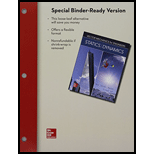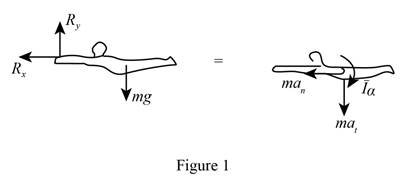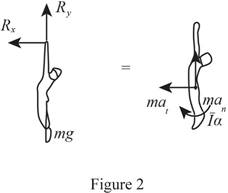
Concept explainers
(a)
The angular velocity of gymnast and the force exerted on his hands after he has rotated through
(a)
Answer to Problem 17.20P
The angular velocity of gymnast and the force exerted on his hands after he has rotated through
The force exerted on gymnast’s hands after he has rotated through
Explanation of Solution
Given information:
The weight (W) of the gymnast is 160 lb.
The centroidal radius of gyration
Calculation:
Find the mass (m) of the gymnast using the equation:
Here, g is the acceleration due to gravity.
Substitute 160 lb for W.
Find the mass moment of inertia
Substitute
Consider position 1 of the gymnast is directly above the bar.
The elevation
Find the potential energy
Substitute 160 lb for W, and 3.5 ft for
At initial position, the gymnast is at rest. Therefore, the velocity
Consider position 2 of the gymnast in which the body of gymnast at level of bar after rotating
Sketch the free body diagram and kinetic diagram of the position 2 as shown in Figure (1).

Refer Figure (1),
At the position 2, the body is in horizontal. Therefore, potential energy
Find the equation of velocity
Substitute 3.5 ft for
Write the equation of kinetic energy
Substitute
Apply the Principle of conservation of energy.
Substitute 0 for
Thus, the angular velocity of gymnast and the force exerted on his hands after he has rotated through
Refer Figure (2),
Find the acceleration
Here,
Substitute 3.5 ft for h.
Find the acceleration
Substitute 3.5 ft for h and
Take moment about mass canter O.
Substitute
Find the horizontal force
Consider equilibrium along horizontal axis.
Substitute
Find the vertical force
Consider equilibrium along vertical axis.
Substitute
Substitute
Find the force
Substitute
Thus, the force exerted on gymnast’s hands after he has rotated through
(b)
The angular velocity of gymnast and the force exerted on his hands after he has rotated through
(b)
Answer to Problem 17.20P
The angular velocity of gymnast and the force exerted on his hands after he has rotated through
The force exerted on gymnast’s hands after he has rotated through
Explanation of Solution
Calculation:
Consider position 3 of the gymnast is directly below the bar after rotating
The elevation
Find the potential energy
Substitute 160 lb for W, and
At initial position, the gymnast is at rest. Therefore, the velocity
Consider position 2 of the gymnast in which the body of gymnast at level of bar after rotating
Sketch the free body diagram and kinetic diagram of the position 3 as shown in Figure 2.

Refer Figure (2),
Find the equation of velocity
Substitute 3.5 ft for
Write the equation of kinetic energy
Substitute
Find the angular velocity
Apply the Principle of conservation of energy.
Substitute 0 for
Thus, the angular velocity of gymnast and the force exerted on his hands after he has rotated through
Refer Figure (2),
The acceleration
Find the acceleration
Substitute 3.5 ft for h and
Find the horizontal force
Consider equilibrium along horizontal axis.
Substitute 0 for
Find the vertical force
Consider equilibrium along vertical axis.
Substitute
Find the force
Substitute 0 for
Thus, the force exerted on gymnast’s hands after he has rotated through
Want to see more full solutions like this?
Chapter 17 Solutions
VECTOR MECH...,STAT.+DYNA.(LL)-W/ACCESS
- CORRECT AND DETAILED SOLUTION WITH FBD ONLY. I WILL UPVOTE THANK YOU. CORRECT ANSWER IS ALREADY PROVIDED. I REALLY NEED FBD. The roof truss shown carries roof loads, where P = 10 kN. The truss is consisting of circular arcs top andbottom chords with radii R + h and R, respectively.Given: h = 1.2 m, R = 10 m, s = 2 m.Allowable member stresses:Tension = 250 MPaCompression = 180 MPa1. If member KL has square section, determine the minimum dimension (mm).2. If member KL has circular section, determine the minimum diameter (mm).3. If member GH has circular section, determine the minimum diameter (mm).ANSWERS: (1) 31.73 mm; (2) 35.81 mm; (3) 18.49 mmarrow_forwardPROBLEM 3.23 3.23 Under normal operating condi- tions a motor exerts a torque of magnitude TF at F. The shafts are made of a steel for which the allowable shearing stress is 82 MPa and have diameters of dCDE=24 mm and dFGH = 20 mm. Knowing that rp = 165 mm and rg114 mm, deter- mine the largest torque TF which may be exerted at F. TF F rG- rp B CH TE Earrow_forward1. (16%) (a) If a ductile material fails under pure torsion, please explain the failure mode and describe the observed plane of failure. (b) Suppose a prismatic beam is subjected to equal and opposite couples as shown in Fig. 1. Please sketch the deformation and the stress distribution of the cross section. M M Fig. 1 (c) Describe the definition of the neutral axis. (d) Describe the definition of the modular ratio.arrow_forward
- using the theorem of three moments, find all the moments, I only need concise calculations with minimal explanations. The correct answers are provided at the bottomarrow_forwardMechanics of materialsarrow_forwardusing the theorem of three moments, find all the moments, I need concise calculations onlyarrow_forward
- Can you provide steps and an explaination on how the height value to calculate the Pressure at point B is (-5-3.5) and the solution is 86.4kPa.arrow_forwardPROBLEM 3.46 The solid cylindrical rod BC of length L = 600 mm is attached to the rigid lever AB of length a = 380 mm and to the support at C. When a 500 N force P is applied at A, design specifications require that the displacement of A not exceed 25 mm when a 500 N force P is applied at A For the material indicated determine the required diameter of the rod. Aluminium: Tall = 65 MPa, G = 27 GPa. Aarrow_forwardFind the equivalent mass of the rocker arm assembly with respect to the x coordinate. k₁ mi m2 k₁arrow_forward
 Elements Of ElectromagneticsMechanical EngineeringISBN:9780190698614Author:Sadiku, Matthew N. O.Publisher:Oxford University Press
Elements Of ElectromagneticsMechanical EngineeringISBN:9780190698614Author:Sadiku, Matthew N. O.Publisher:Oxford University Press Mechanics of Materials (10th Edition)Mechanical EngineeringISBN:9780134319650Author:Russell C. HibbelerPublisher:PEARSON
Mechanics of Materials (10th Edition)Mechanical EngineeringISBN:9780134319650Author:Russell C. HibbelerPublisher:PEARSON Thermodynamics: An Engineering ApproachMechanical EngineeringISBN:9781259822674Author:Yunus A. Cengel Dr., Michael A. BolesPublisher:McGraw-Hill Education
Thermodynamics: An Engineering ApproachMechanical EngineeringISBN:9781259822674Author:Yunus A. Cengel Dr., Michael A. BolesPublisher:McGraw-Hill Education Control Systems EngineeringMechanical EngineeringISBN:9781118170519Author:Norman S. NisePublisher:WILEY
Control Systems EngineeringMechanical EngineeringISBN:9781118170519Author:Norman S. NisePublisher:WILEY Mechanics of Materials (MindTap Course List)Mechanical EngineeringISBN:9781337093347Author:Barry J. Goodno, James M. GerePublisher:Cengage Learning
Mechanics of Materials (MindTap Course List)Mechanical EngineeringISBN:9781337093347Author:Barry J. Goodno, James M. GerePublisher:Cengage Learning Engineering Mechanics: StaticsMechanical EngineeringISBN:9781118807330Author:James L. Meriam, L. G. Kraige, J. N. BoltonPublisher:WILEY
Engineering Mechanics: StaticsMechanical EngineeringISBN:9781118807330Author:James L. Meriam, L. G. Kraige, J. N. BoltonPublisher:WILEY





